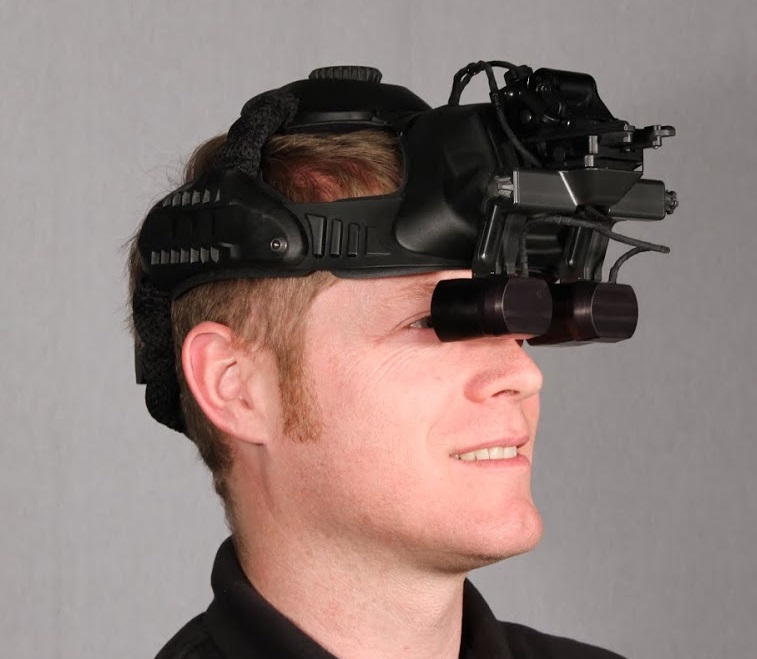SA Photonics SA-65
August 2014
Note: I currently work for SA Photonics and I’m responsible for a lot of our head mounted display (HMD) electronics. I also perform the system level test as well as write the demo applications when we show potential customers. You will even see my face on the datasheet for the SA-65. I wanted to state that before jumping into a review of the SA Photonics SA-65 HMD.

The SA Photonics SA-65 head mounted display is a very high end military grade HMD. The SA-65 uses twin 1920×1200 eMagin OLED microdisplays to give a 65 degree diagonal field of view (FOV). The optics are custom designed by SA Photonics. The SA-65, and its sister the SA-36, were the first full HD OLED HMDs I had the chance to use and it made me a firm believer in using OLED microdisplays. The imagery is quite beautiful. The colors are very brilliant and the blacks very deep. The FOV of the 65 also provides a good level of immersion and at the same time maintains an acceptable resolution. For those who absolutely need the highest resolution, the SA-30 is an alternate choice with <1 arcmin/pixel. Personally I'm willing to trade some resolution for FOV.
The SA-65 is head mounted using a Skullcrusher head mount which is one of the most comfortable head mounts I’ve ever worn. A lot of time was spent trying to find the most comfortable head mount available. Between the Skullcrusher and the actual interpupillary distance (IPD) shelf of the HMD is a Norotos AKA2 mount. The AKA2 is a standard night vision goggle (NVG) mount used by the military. It also happens to have most of the adjustments needed for an HMD like fore/aft, vertical, and tilt. It’s also extremely rugged as you might imagine.
The AKA2 then mounts to the SA-65 IPD shelf. Everything from the IPD shelf and down was custom designed by SA Photonics. The IPD shelf provides IPD adjustment (imagine that!) and holds the arms to the eyepieces. This HMD was designed to support situational awareness so you’ll notice that the eyepiece do not have eyecups and do not cut you off from your surrounding world. This was intentional. In many applications you want an HMD for viewing remote imagery, say from a unmanned ground vehicle, but you don’t want to cut the user off completely from the surrounding world. With the SA-65 (and the SA-36) the user can still look down and see any controls they may be using or around their peripheral vision. If immersion is required eyecups could be used.
On the back of the Skullcrusher is a small electronics box that holds the microdisplay driver electronics. Every SA-65 system moving forward will contain microdisplay driver electronics designed by myself. I’m very proud of these driver electronics as they incorporate many of the lessons learned over the last 5 years of troubleshooting and debugging other 3rd party driver electronics. The new electronics have brightness buttons and a power switch provided to the user for adjustments. There are also numerous other internal features to make the electronics more robust such as over voltage protection and ESD protection. Out of the electronics are twin micro HDMI connectors for video and a micro USB for power and factory configuration. These exit downwards along the neck line. The new electronics can run cable lengths of 25′ or more. The dual video inputs provide stereo 3D using dual output mode. There’s even very early support for frame sequential stereo if requested.
The SA-65 does require distortion correction of the imagery prior to sending it to the HMD. The reason is that the optics are being pushed to the limits in order to achieve the 65 degree diagonal FOV. The corrected imagery when presented to the eye gives the 55 deg. H.FOV (65 deg. diagonal). If you’re willing to let the resolution drop off a bit at the edges you can actually stretch the image slightly and give almost 60 degrees H.FOV. You can see an uncorrected image of the SA-65 FOV on my FOV comparison page here. When I run a Battlefield 4 demo for customers I actually stretch the FOV to 60. Distortion correction is pretty standard these days using GPU shaders and that’s how I implement it for the SA-55.
I’ve now had the pleasure to fit probably over 200 people using the SA-65, SA-36, and SA-62 HMDs. The response is always “Wow!”. The best experiences are with skeptics who say they’ve seen HMDs many times before and weren’t impressed. Getting a “Wow” from those users always brings a smile to my face.
 Mellott's VR
Mellott's VR